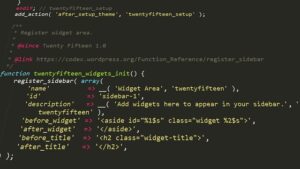Table of Contents
Does Google use ReactJS? This is a pertinent question that has been asked by many, as ReactJS has become quite a popular platform for developing websites and applications. It has become a go-to choice for any company who are looking to dip their toes into the web development world – which seems to encompass increasingly more of our daily lives. But does the world’s leading tech giant opt for ReactJS when it comes to their own projects, or have they gone for something else entirely?
It is no secret that ReactJS is a powerful front-end platform, so it is easy to understand why it would be attractive to any company large or small. What exactly is so appealing about ReactJS though? It is known for its ability to handle large workloads and is a great choice for building scalable applications. Additionally, with a wide variety of components comprising it, it offers an immense amount of flexibility and customizability for developers.
A solid understanding of what ReactJS can do is critical in order to answer the crucial question: Does Google use ReactJS? From analyzing their large range of projects, it appears that Google does indeed use ReactJS for many of their largest web offerings. They have utilized ReactJS for projects such as their Chrome browser and Google Docs, among others. Many believe that this popularity among tech giants is further proof of ReactJS’s status as a powerful and reliable development platform.
In this article, you will learn about why ReactJS appeals to tech giants, why Google has utilized it, and the implications of their choice. Additionally, insight will be given into some of the potential downsides of using ReactJS, and when you should not use it. It will provide an all-encompassing overview of the ReactJS platform, and give you the tools needed to help make a well-informed decision as to whether or not Google should be using ReactJS for their own projects.

Definitions
ReactJS is an open-source JavaScript library used for building user interfaces and web applications. It was created by a team at Facebook and is now maintained by a community of developers. It allows developers to create highly interactive user interfaces and handle the dynamic data that often powers web applications.
Google is a multinational technology company that specializes in Internet-related products and services, such as search, cloud computing, and software.
The ReactJS library was designed with an application programming interface (API) that allows developers to create components, which are reusable code chunks. These components can be combined and reused in different parts of the application. The components are also flexible and can be easily changed without having to rewrite the entire application code.
Google does not currently use ReactJS in its core products and services. But it does offer React as an open-source library for developers to use. Google does provide some of its own tools and libraries for developers, such as Angular and Flutter.
React is being used by a lot of companies and is increasing in popularity among developers. Companies like Airbnb, Walmart, and PayPal have adopted it into their product development process. By providing an open-source library for developers to use, Google can keep up with the changing trends in web development.
In short, ReactJS is an open-source library used for building interactive user interfaces and web applications. Google does not use React in its core products and services, but does offer it as an open-source library for developers.
Fundamental Principles of ReactJS
Fundamental Principles of ReactJS
Reactive User Interfaces
ReactJS is a javascript library created by Facebook in 2013 to provide a reactive user interface. It is an open-source library that is used primarily for building user interfaces for web applications. It is designed to improve the efficiency and speed of web application development. ReactJS is popularly used to create a single-page application that provides a responsive view of the application from a single source. It uses a combination of JavaScript, HTML, and CSS to create web applications.
ReactJS takes the UI component of an application and creates a reusable code component. This component will then be used to render a view in the browser. The components are also able to handle events that corresponds to the action of the user. The other main feature of ReactJS is that it can render quickly so users can have a faster loading page. This also helps in reducing the number of unnecessary DOM manipulations, making the application more efficient.
ReactJS also supports unidirectional data flow. In ReactJS, the developers create a flow of data which flows from a parent component to its child components. This type of data flow ensures that changes to the data are communicated downwards and not upwards. This helps reduce the complexity of debugging bugs as the changes are propagated in a predictable manner.
Virtual DOM
One of the main features of ReactJS is that it uses a virtual Document Object Model (DOM). A virtual DOM is a representation of the original DOM stored in memory. It is beneficial because it can be updated quickly, even if there are hundreds of nodes. This helps ReactJS optimize performance as ReactJS will only need to update the virtual DOM once.
The virtual DOM is a representation of the HTML DOM structure, and it is reactively updated whenever an event is triggered. ReactJS compares the virtual DOM with the real DOM and updates the nodes on the real DOM that needs to be updated. This helps make the page load faster as it reduces the number of DOM manipulations.
Components
Components are at the heart of ReactJS. It is the building blocks of ReactJS applications. A component is a part of the application that can be rendered and reused again and again. The components are responsible for the look of the application and how the user interacts with it. It also helps in the organization of the application. The components are bundled together to form a single webpage.
Components are also responsible for the application’s data and state management. The data for each component can be managed individually, and each component is responsible for updating the state of the parent component when necessary. This helps to keep the application organized and consistent.
Conclusion
ReactJS is a popular and powerful library for creating user interfaces for web applications. It is a javascript-based library designed to help developers create a faster, more reactive web application. ReactJS uses a virtual DOM for faster loading pages and unidirectional data flow for predictable communication between components. Components are also at the heart of ReactJS and are responsible for how the application looks and the data and state of the application.
Useful Resources
Benefits of ReactJS for Google
No matter if it’s a general search engine or specialized designs like Google’s web apps suite, interface design requires a modern library and platform to provide a consistent and intuitive experience for the users. This is where ReactJS comes in.
React, as a JavaScript library, revolutionizes the way that engineers design interactive user interfaces for web and mobile platforms. As an open source project, Google joined the development community early on, hoping to unlock potential solutions for their product range.
Components and the Virtual DOM
Features of React are clearly defined and intuitively organized for engineers to combine and reconstruct without having to research the transactions behind user interactions or interface directives. The component-based structure simplifies complicated processes of development, allowing engineers to build projects quickly and with fewer errors. React also offers an ‘Virtual DOM’, meaning that elements and states can be updated without needing to overwrite the whole tree of elements that make up any user interface.
Easy Interaction between Projects
The same library of components, ‘React Native’, is versatile enough to work with other JavaScript development platforms, such as Meteor and NativeScript. This makes it easier for teams to overlap frameworks with ease. With the same language and syntax that powers mobile applications and web development, for both iOS and Android, React helps Google to grow its product range more quickly and in a much more uniform way.
Flexibility and scalability are paramount when developing for mobile devices, as data needs to be managed and committed accordingly for the best user experience. React helps developers to specialize and compartmentalize specific elements to ensure features can be maintained, updated and extended, with little to no disruption of existing code.
ReactJS is a well-established and highly regarded development tool compatible with many operations. Its components allow developers to create advanced interfaces and optimize their applications for speed and scalability. This is why Google has recognized the value in using this library for web and mobile projects, such as Google environments and products.
Problems which ReactJS Solves for Google
Yes, Google utilizes ReactJS for many of its web applications and projects. ReactJS is a JavaScript library that was created by software engineer Jordan Walke at Facebook. It was initially released in 2013 and is now maintained by a community of developers as well as Facebook and Instagram. Google utilizes ReactJS to build user interfaces for their SPA (Single Page Applications) with great efficiency, in order to offer users tailor-made experiences.
What Are the Advantages of ReactJS For Google?
The major advantages of ReactJS for Google are speed, scalability, and simplicity. By making use of reactive components, developers can create interactive user interfaces quickly and easily. ReactJS is also lightning fast, since it uses a virtual DOM which makes it much quicker than other frameworks. Additionally, it is easier to maintain and keep up-to-date since it does not need to be rewritten for each successive version.
What Specific Problems Does ReactJS Solve For Google?
ReactJS helps Google achieve a wide range of tasks. Part of the expediency of ReactJS lies in its ability to render content quickly. By using ReactJS, Google can offer users optimal experiences by rendering dynamic content such as images, sound, or videos swiftly and without crashing the entire application. ReactJS also enables Google developers to create powerful UIs that are consistent across multiple devices. It provides an environment in which developers can separate concerns of application state into different components that can then communicate efficiently with each other.
Google also makes use of ReactJS for its reliable server-side rendering. Server-side rendering helps optimize JavaScript for SEO, allowing for better search engine rankings. ReactJS, with its one-way data binding, is able to quickly display content without having to reload each page. This ultimately helps improve page load times and enhances the user experience.
Overall, ReactJS is a valuable tool for Google, providing a range of benefits to their users and enhancing their SPA applications with speed, scalability, and simplicity. By utilizing the library, Google has become well known for its interactive UIs which offer users tailor-made experiences.
Conclusion
When it comes to the topic of whether or not Google uses ReactJS, it is an intriguing question that has yet to be fully answered. As Google is renowned for using cutting-edge technology, many have speculated as to the answer. Yet, without definitive proof from Google itself, it remains a mystery. What isn’t a mystery, however, is the impact ReactJS has had on development.
If you’re interested in delving into the world of ReactJS, and the potential connection with Google, be sure to follow this blog. We will provide updates and new releases as they come available. You won’t want to miss out on the potential inside scoop as we uncover more information on the topic.
To further clarify the questions you might have, here is a helpful FAQ section:
Does Google use ReactJS? At this time, there is no definitive answer. Google itself has yet to comment on the potential use of ReactJS on their platform.
What is ReactJS? ReactJS is a JavaScript library for creating user interfaces and it is developed and maintained by Facebook. It is one of the more popular frameworks for creating websites and applications.
What are the advantages of ReactJS? ReactJS offers a speedy response time due to its virtual DOM, it is SEO-friendly and it is also open source. All these factors make it one of the more popular options for developing web and mobile applications.
What type of projects is ReactJS best suited for? ReactJS is primarily used for building complex user interfaces and single-page applications. It is well known for its scalability and its ability to create flexible, responsive designs.
Where can I learn more about ReactJS? There are a number of online tutorials and courses available for ReactJS. It is easy to find free and paid classes that will help you explore and get the most out of this popular development framework.

